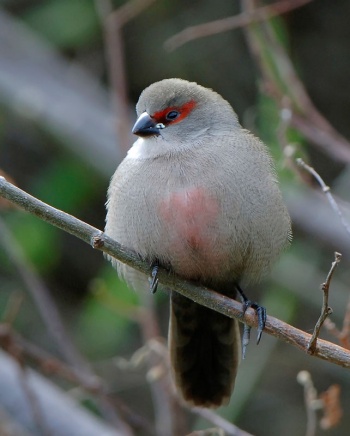- Estrilda astrild
Identification
9·5–13 cm (3¾-5 in)
- Greyish-brown body with dark brown bars
- Red eyestripe
- White cheeks and throat
- Red stripe along centre of belly
- Brown rump
- Dark tail
- Bright red bill
Female: similar, paler, less red on belly
Juvenile: little or no red on belly, fainter barring, black bill
Distribution
Most of sub-Saharan Africa
Western Africa: Guinea, Mali, Sierra Leone, Liberia, Ivory Coast, Ghana, Togo, Benin, Nigeria, Cameroon, Central African Republic, Equatorial Guinea, Gabon, Democratic Republic of Congo and Angola
Eastern Africa: South Sudan, Ethiopia, Somalia, Kenya, Uganda, Rwanda, Burundi, Tanzania, Mafia Island, Zambia, Mozambique and Malawi
Southern Africa: Namibia, Botswana, Zimbabwe, South Africa, KwaZulu-Natal, Lesotho and eSwatini
African Islands: Gulf of Guinea Islands, Bioko (Fernando Po)
Introduced to Ascension Island, South America, Spain, and Hawaii.
Taxonomy
Subspecies
Estrilda astrild has 15 subspecies:1:
- E. a. kempi: Sierra Leone to southern Guinea and Liberia
- E. a. occidentalis: Ghana to Central African Republic, middle Congo River and north-eastern DRC; winters to Bioko
- E. a. rubriventris: Coastal Gabon and lower south-western Congo to north-western Angola
- E. a. jagoensis: Coastal western Angola (Benguela and Moçamedes)
- E. a. angolensis: Plateau of western Angola
- E. a. niediecki: Angola to south-western Zambia, north-eastern Namibia, northern Botswana and western Zimbabwe
- E. a. damarensis: Namibia and north-western Cape Province
- E. a. peasei: Ethiopia
- E. a. macmillani: South Sudan
- E. a. adesma: Uganda to eastern DRC, Rwanda, Burundi, western Kenya, north-western Tanzania
- E. a. minor: Southern Somalia to eastern Kenya, north-eastern Tanzania, Zanzibar and Mafia Island
- E. a. massaica: Kenya east of Rift Valley to interior northern Tanzania
- E. a. cavendishi: Tanzania, south-eastern DRC, Zambia, Malawi to Zimbabwe, Mozambique
- E. a. astrild: Western South Africa and south-eastern Botswana
- E. a. tenebridorsa: Eastern South Africa, Lesotho and eSwatini
In addition four other subspecies, ngamiensis, schoutedeni, sousae and nyansae, are not generally recognised2.
Habitat
Long grass, scrub and reeds, often near water.
Behaviour
Breeding
The ball shaped nest is built in a cavity from grass; there is a downward-pointing entrance tube on one side. The 4-7 white eggs hatch after 11-13 days and are incubated and cared for by both adults until they fledge 17-21 days later.
Diet
The diet includes grass seeds and some insects.
References
- Clements, J. F., T. S. Schulenberg, M. J. Iliff, D. Roberson, T. A. Fredericks, B. L. Sullivan, and C. L. Wood. 2017. The eBird/Clements checklist of birds of the world: v2017, with updates to August 2017. Downloaded from http://www.birds.cornell.edu/clementschecklist/download/
- Avibase
- Handbook of the Birds of the World Alive (retrieved September 2016)
- Wikipedia
Recommended Citation
- BirdForum Opus contributors. (2024) Common Waxbill. In: BirdForum, the forum for wild birds and birding. Retrieved 9 November 2024 from https://www.birdforum.net/opus/Common_Waxbill
External Links
Search the Gallery using the scientific name:
Search the Gallery using the common name:
GSearch checked for 2020 platform.





